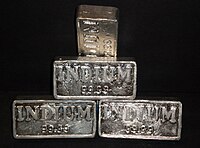
Photo from wikipedia
Spent liquid crystal displays (LCDs) are a secondary source of precious/strategic metals, including indium (In). The present study involved optimizing the solubilization of this strategic element from samples of indium… Click to show full abstract
Spent liquid crystal displays (LCDs) are a secondary source of precious/strategic metals, including indium (In). The present study involved optimizing the solubilization of this strategic element from samples of indium tin oxide (ITO) glass prepared from LCD screens of computer monitors and laptop screens. The influence of operating conditions on In solubilization, as well as optimum conditions for sulfuric acid leaching were defined by a Box-Behnken-type experimental design methodology. Optimum operating conditions include a leaching step for 30 min at a temperature of 70 °C in the presence of 0.4 N H2SO4 and a pulp density of 50% (w/v). Under these conditions, the quadratic model established to predict the solubilization of In from ITO glass samples provided an In solubilization efficiency of 89.7%, which was validated experimentally (99.5%). The analysis of direct operating costs and capital costs for the implementation of such a leaching process revealed that the process is conceivable for a high-capacity plant processing ~100 t/day of ITO glass.
Journal Title: Waste management
Year Published: 2020
Link to full text (if available)
Share on Social Media: Sign Up to like & get
recommendations!